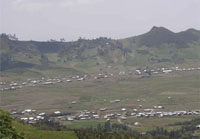6.1.1 Temperature
The ranges of minimum and maximum temperature greatly affect the development of the malaria parasite and its mosquito vector, which determines malaria transmission.
Temperature and parasite development
Temperature affects the life cycle of the malaria parasite. The time required for the parasite to complete its development in the gut of the mosquito is about 10 days, but it can be shorter or longer than that depending on the temperature. As the temperature decreases, the number of days necessary to complete the development increases for a given Plasmodium species. P. vivax and P. falciparum have the shortest development cycles and are therefore more common than P. ovale and P. malariae.
The time needed for the parasite to complete its development in the mosquito, decreases to less than 10 days as temperature increases from 21°C to 27°C, with 27°C being the optimum. The maximum temperature for parasite development is 40°C. Below 18°C, the life cycle of P. falciparum in the mosquito body is limited. The minimum temperatures are between 14–19°C, with P. vivax surviving at lower temperatures than P. falciparum. Malaria transmission in areas colder than 18°C can sometimes occur because the Anopheles often live in houses, which tend to be warmer than the outside temperature.
Temperature and mosquito development
Development of the mosquito larva also depends on temperature – it develops more quickly at higher temperatures. Higher temperatures also increase the number of blood meals taken and the number of eggs laid by the mosquitoes, which increases the number of mosquitoes in a given area.
The minimum temperature for mosquito development is between 8–10°C; the optimum temperature is 25–27°C, and the maximum temperature for is 40°C.
Altitude and temperature
As you saw in Figure 5.3 in the previous study session, altitude (elevation above sea level) is one of the most important factors that determines the pattern of malaria transmission in Ethiopia. Altitude in Ethiopia varies from 100 metres below sea level to more than 4,000 metres above sea level. Altitude influences the distribution and transmission of malaria indirectly, through its effect on temperature. As altitude increases, temperature decreases, so highlands are colder and lowlands are warmer.
In the Ethiopian highlands, with altitudes between 2,000 and 2,400 metres, malaria transmission occurs for short periods only when temperatures rise unusually high.
Can you explain why transmission occurs during these periods?
The increased temperature allows the development of parasites to occur in the mosquitoes, and the mosquito population also increases as the temperature rises.
Beyond 2,400 metres, the temperature does not go high enough to support malaria transmission and these areas are free of malaria.
Addis Ababa is free of malaria, and most of the Ethiopian highlands above 2,000 metres have little or no locally transmitted malaria (Figure 6.1). The most important reason for this is that it is generally too cold in the highlands for mosquitoes to develop in large numbers, or for the malaria parasite to develop inside the vector.

Equatorial Africa
Now look back at the map showing the distribution of malaria in Africa (Figure 5.2 in the previous study session). From your school geography education, you may remember that temperatures are higher around the equator and do not vary much through the year. Temperatures decrease progressively as you move north or south of the equator. The red part of the map shows a very high level of transmission around the equator and the light blue colour represents lower malaria transmission further north and south of the equator. One of the reasons for high levels of transmission near the equator is the warm and relatively constant temperature in tropical Africa.
6.1 Climatic factors
